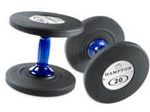Dumbbells are among the most widely-used fitness equipment—but few people realize just how much they vary with regard to comfort, function and durability. If you’re in the market for high-quality free weights, use this guide to understand some important points of differentiation.
First, the factors that drive overall dumbbell quality are three-fold: materials, grip and weight distribution. Let’s discuss each one.
Materials: Most dumbbells are made of either cast iron or stainless steel, and the difference is huge. Cast iron dumbbells present several disadvantages. First, inherent imperfections in the manufacturing process (i.e. air bubbles that get trapped inside) can alter the overall weight and distribution by as much as 10%. What’s more, cast iron weights are susceptible to hairline cracks and breakage—including chipping, a serious safety hazard.
In addition, watch out for rubber-coated dumbbells. Rubber-coated dumbbells may cost less, but at a price. Not only do rubber-coated dumbbells have a distinctly strong odor (which can be unpleasant and even overwhelming for many users), but dumbbells made with rubber can also degrade from handling and sunlight.
Urethane-coated dumbbells cost a bit more, but hold their value. Urethane is more durable, impact-resistant and shock absorbent than rubber. Plus, it has a higher tear-strength than rubber, meaning urethane-coated dumbbells typically have a longer warranty period when compared to rubber. Finally, urethane does not produce an odor, even over time.
Grip: Two important features determine a quality grip—knurling and ergonomics. With regard to knurling (crosshatching engraved on the handle to reduce slippage), a high-quality knurling can help you maintain proper form and complete more repetitions—while poor knurling can literally shred your palms.
Ergonomics are another key consideration. Check for crosshatching, but even more importantly, look at the shape. Tapered dumbbell handles allow your fingers to wrap around evenly, enabling muscles and tendons in your wrist to maintain proper form. (With a non-tapered handle, your middle two fingers do most of the work—straining your wrist, causing fatigue and loss of form).
Weight Distribution: A major feature of traditional hex-head dumbbells is that by default, length increases with weight. Among heavier hex-head dumbbells, this length hinders their efficacy—limiting range of motion and preventing completion of certain exercises. By contrast, high-quality pro-style dumbbells (like Hampton, which use interchangeable weighted discs) distribute weight more evenly across a shorter span—putting less stress on your wrist even at heavier weights, and giving you mechanical advantages that hex-heads can’t.
One more important point: While dumbbell storage is rarely top-of-mind, it’s an issue to consider. Traditional hex-head dumbbells offer limited (and often unwieldy) storage options, while disc and pro-style dumbbells offer more flexibility for smaller spaces.
Overall, when considering which free weights are right for you, don’t be driven by price alone. Investing in high-quality dumbbells made from better materials—and with better grips and weight distribution—can make all the difference in the enjoyment of your purchase.
Contact a local Gym Source equipment expert today to get started.

